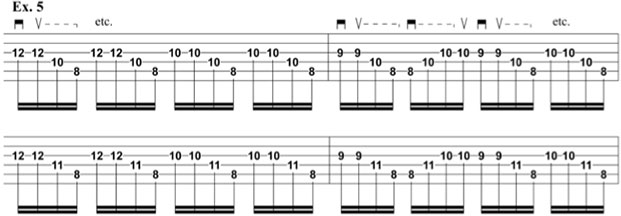Applying Sweep Picking to Unorthodox Passages
Learn how to apply sweep picking to playing situations that aren’t arpeggios or triadic in nature.

Welcome back, minions. Are you ready to get your sweep on? This time, we’re going to take the sweep picking patterns from the last lesson and apply them to other playing situations that aren’t arpeggios or triadic in nature.
How about sweeping through the pentatonic scale. “What? The old blues box?!? Sweeping?? What devilry is this?!?!” I can hear you whining from here, so check out EXAMPLE 1 and quit your sniveling.

By taking the down followed by three upsweeps pattern and arranging it this way, it actually rolls across the fretboard quite smoothly. It also gives you a pentatonic run that sounds a bit more fresh and unpredictable because of the resulting larger intervals. In 1c, the four-note sequences descend and go against the grain of the larger ascending line. All the cool kids are doing it.
Want more pentatonic examples? EXAMPLE 2 combines the two patterns from my last column into a speedy descending blur. I encourage you to try this with a metronome set to a faster click and play the subdivisions. In other words, reduce the 16th-note triplets to eighth-note triplets, and the 32nd notes to 16hs at a faster tempo. This will help you to differentiate between the groupings of threes and fours.

Septuplets are a great rhythmic challenge for even the most seasoned shredder, but they sound pretty sweet when you can really nail them. EXAMPLE 3 demonstrates one method of blending sweep and alternate picking, something I will address at length in the blogs to come.

The Hirajoshi scale is a Western approximation of tunings used by Japanese stringed instruments like the shamisen or koto. In theory terms, it can most easily be expressed with scale degrees 1, 2, b3, 5 and b6 (or 1, 2, 3, 5 and 6 of the Aeolian or natural minor scale). EXAMPLE 4a presents the basic scale starting on the 13th fret, while 4b arranges the scale into the same sequential sweeping pattern from EXAMPLE 1. 4c uses a new sweeping pattern with groupings of five as an alternate method of ascending. If you are unfamiliar with this scale, do yourself a favor and go listen to some Marty Friedman solos immediately.

These patterns can also be applied to more riff-oriented passages. EXAMPLE 5 is a sneak peek of a prototype riff going on the next Lords of the Trident record, so plagiarize with caution, or send me a royalty check.
All the latest guitar news, interviews, lessons, reviews, deals and more, direct to your inbox!

The key to all of this technical playing is repetition (obviously), not only to learn it and get it right, but also to get so completely familiar and comfortable with it that these patterns and ideas start to organically work their way into your solos and improvisation. Until next time, I’ll see you out on the battlefield.
Baron Taurean Helleshaar is a roaming sell sword and scholar of the forbidden “Music of the Arcane." He has formed an allegiance with the Lords of the Tridentwhile remaining in exile from his home in the Northern Kingdom. His mortal alter ego, Brian Koenig, is lead guitarist for the band Lords of the Trident and teaches music privately in Madison, Wisconsin. He was a founding member of Luna Mortis (Century Media) and has toured the U.S. and Canada. He holds a master's of music in composition from the University of North Carolina at Greensboro and a bachelor's of music in music theory and history from the University of Wisconsin Whitewater.
